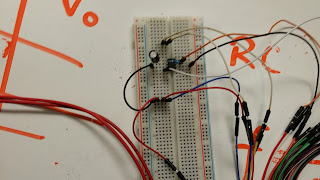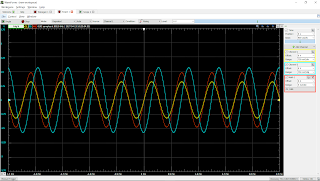4/25/2017
In class we learned on replacing either output resistance or the input resistance in an inverting op amp which will give us an integrator or a differentiator.
A problem we did about replacing output resistor to create an integrator:
Another example, which we calculate a practical integrator:
We also were taught of singularity, and the 3 different functions of unit step, unit ramp, and unit impulse function.
unit step function (u(t)) is the derivative of unit ramp (r(t)), and the derivative of step function is the unit impulse function( sigma(t)).
An example that we did in class with regards to these functions:
"Inverting Differentiator" Lab:
Prelab:
Measuring resistance;
The circuit:
The graph obtained using scope at f=100hz:
The graph obtained using scope at f=250hz:
The graph obtained using scope at f=500 hz:
The calculation that we did using theoretical and experimental values:
Sunday, April 30, 2017
Tuesday, April 25, 2017
4/18/2017 Class activities + "Passive RC Circuit Natural Response" + "Passive RL Circuit Natural Response"
4/18/2017
Class Activities:
Calculating the equivalent inductance of multiple inductors:
Calculating the voltage as a function of time in the case of discharging capacitor in a source free RC circuit:
Calculating the Energy dissipated by the resistor in a source free RC circuit after time of 5 time constants ( Which is where engineers say is the time needed to completely discharge a capacitor):
Calculating the maximum switch frequency of a capacitor:
Another problem calculating voltage as a function of time in the case of discharging capacitor in a free source RC circuit:
Calculating the current of a discharging inductor in a source free RL circuit:
"Passive RC Circuit Natural Response":
Pre-lab:
Calculating the theoretical time to charge and discharge the capacitor in the designated circuit and a diagram of the circuit:
Value of the first resistor (theoretical 2k ohms):
Value of the second resistor (theoretical 1k ohm):
Oscilloscope on the charging capacitor:
Oscilloscope on the discharging capacitor:
Oscilloscope on the square wave:
a gif of the square wave:
The values:
maximum potential difference in the capacitor when it is fully charged:
"Passive RL Circuit Natural Response"
Prelab:
Oscilloscope for the square wave:
(In the wavegen square wave frequency is set to 1.8khz):
Summary:
- 5 time constant is a good estimation both theoretically and experimentally for time to completely discharge a capacitor
- Trigger switch is a good tool to utilize in waveform if we want to record something that happens once in a short period of time, such as charging or discharging a capacitor.
- We could calculate inductance from the time for the inductor to discharge and the thevenin resistance of the circuit (L~R*t_discharge/5)
Class Activities:
Calculating the equivalent inductance of multiple inductors:
Calculating the Energy dissipated by the resistor in a source free RC circuit after time of 5 time constants ( Which is where engineers say is the time needed to completely discharge a capacitor):
Calculating the maximum switch frequency of a capacitor:
Another problem calculating voltage as a function of time in the case of discharging capacitor in a free source RC circuit:
Calculating the current of a discharging inductor in a source free RL circuit:
"Passive RC Circuit Natural Response":
Pre-lab:
Calculating the theoretical time to charge and discharge the capacitor in the designated circuit and a diagram of the circuit:
Value of the first resistor (theoretical 2k ohms):
Oscilloscope on the charging capacitor:
Oscilloscope on the discharging capacitor:
Oscilloscope on the square wave:
a gif of the square wave:
The values:
maximum potential difference in the capacitor when it is fully charged:
values:
"Passive RL Circuit Natural Response"
Prelab:
Oscilloscope for the square wave:
Summary:
- 5 time constant is a good estimation both theoretically and experimentally for time to completely discharge a capacitor
- Trigger switch is a good tool to utilize in waveform if we want to record something that happens once in a short period of time, such as charging or discharging a capacitor.
- We could calculate inductance from the time for the inductor to discharge and the thevenin resistance of the circuit (L~R*t_discharge/5)
Sunday, April 16, 2017
4/13/2017 Class Notes + "Capacitor Voltage-current Relations" + "Inductor Voltage-current Relations" Lab
Class Notes:
The class begins with Professor Mason asking us our prediction of inductor and capacitor in a DC circuit, and also why ragebridge makes spark when it first turn on.
We then were told to derive the unit of permittivity:
After that we derive how capacitor would behave in a dc circuit after it is charged, where it would act as open circuit.
We then practice on getting equivalence capacitance in a circuit , where parallel would add up their capacitance, while series would add the inverses of the capacitance(the calculation of capacitance equivalence in series is like resistor in parallel, and vice versa).
After that we derive the relation between current and voltage in capacitor:
We also derive the relation between current and voltage in inductors:
Professor Mason finally showed us something cool, where he blew up an electrolytic capacitor:
well the fried sausage demo was pretty good, but nowhere close to this demo (more explosion demo please!).
This explosion happen when the capacitor is fed electricity from its negative side and not its opposite side. This is the negative side of a capacitor( it has - sign posted there):
"Capacitor Voltage-current Relations" Lab:
Prelab:
Circuit design for the experiment, and the prediction of the current vs voltage graph in the cases of cos function and a triangle function:
This lab's circuit is pretty simple in design, but I learn that we actually has 2 scopes in the analog discovery, where it is the previously known orange-orange white as the first scope and blue-blue white cable as the second scope.
Closeup of the circuit:
Datas obtained:
- Using sin function in the wavegen with a frequency of 1kHz:
The class begins with Professor Mason asking us our prediction of inductor and capacitor in a DC circuit, and also why ragebridge makes spark when it first turn on.
We then were told to derive the unit of permittivity:
After that we derive how capacitor would behave in a dc circuit after it is charged, where it would act as open circuit.
We then practice on getting equivalence capacitance in a circuit , where parallel would add up their capacitance, while series would add the inverses of the capacitance(the calculation of capacitance equivalence in series is like resistor in parallel, and vice versa).
After that we derive the relation between current and voltage in capacitor:
We also derive the relation between current and voltage in inductors:
Professor Mason finally showed us something cool, where he blew up an electrolytic capacitor:
well the fried sausage demo was pretty good, but nowhere close to this demo (more explosion demo please!).
This explosion happen when the capacitor is fed electricity from its negative side and not its opposite side. This is the negative side of a capacitor( it has - sign posted there):
"Capacitor Voltage-current Relations" Lab:
Prelab:
Circuit design for the experiment, and the prediction of the current vs voltage graph in the cases of cos function and a triangle function:
This lab's circuit is pretty simple in design, but I learn that we actually has 2 scopes in the analog discovery, where it is the previously known orange-orange white as the first scope and blue-blue white cable as the second scope.
Closeup of the circuit:
Datas obtained:
- Using sin function in the wavegen with a frequency of 1kHz:
The cosine wavegen aka the sin wave offset by 90 degrees
The scope, where the blue one is the voltage measuring the capacitor voltage, yellow is the one measuring the voltage difference across the resistor, and red(orange?) is the current going through the resistor, which is obtained using the math function by dividing the voltage across the resistor by 100 (the resistance of the resistor).
a not so exciting gif ( it stayed in place ;( )
- Using the sin function in the wavegen at 2kHz frequency:
'cosine' wavegen at f=2kHz
The scope, similar to the previous one, where the blue one is the voltage measuring the capacitor voltage, yellow is the one measuring the voltage difference across the resistor, and red(orange?) is the current going through the resistor, which is obtained using the math function by dividing the voltage across the resistor by 100 (the resistance of the resistor).
Another not so obvious gif attempt that looks like a still picture :(
- Using the triangle function with f=100 Hz:
Triangle on the wavegen, phaseshifted by 90 degree
Triangle function, where blue = voltage across the capacitor, yellow is the voltage across the resistor, and red(orange?) is the current across the resistor obtained from the custom math function by dividing the voltage across the resistor by 100.
We noticed that the current graph is not as square as we had expected, which Professor Mason said that it was due to the acceleration also having derivatives like snap, crackle, and pop, which makes it highly impossible to be dropping in a square manner, and instead work in a continuous manner, making that graph.
here is the gif of the triangle function . Notice that they are always 90 degree out of phase.
"Inductor Voltage-current Relations" Lab
Well the prelab for this lab is exactly like the one in the "Capacitor Voltage- current Relations" lab, with the difference being we are using an inductor in the place of the capacitor. We redid the sketch of the current for the inductor, whereas instead of taking the derivative of the voltage, we integrate the voltage, where we end up with a positive sin function rather than a negative sin function
Picture of the circuit:
That inductor is larger by quite a bit compared to the capacitor used from the previous activity.
Here is the graphs obtained:
- sin function with f=1kHz:
Instead of the - sin current like the one from the capacitor, we get a + sin current when paired up with a cos voltage. There is a slight phase shift between the two compared to the one in the capacitor, which Professor Mason said to have something to do with the coil within the inductors.
- Sin function with f=2kHz:
This one has slightly closer to 90 degree phase shift between the two as opposed to the first one.
Summary:
Capacitor's relation between voltage and current is that the current is the derivative of the voltage(the slope of the voltage graph). The Inductor's relation between voltage and current is that the current is the integral of the voltage(the area of the voltage graph).
Subscribe to:
Comments (Atom)



















































